Learning the friendly way
Dive into our resources, guides, and articles for all things money-related. Grow your financial confidence with our experts curated tips and articles for both experienced and new investors.
LATEST ARTICLEs

Stocks are essentially shares in a company that the company sells to shareholders in order to raise money. Shareholders are then entitled to dividends if the company succeeds, and might also receive voting rights when the company makes big decisions (depending on the company).
When you invest in stocks, you’re putting your money to work so it can potentially increase in value over time and generate capital gains, dividends, and long-term financial independence. Instead of letting inflation quietly reduce your spending power, investing allows you to build a portfolio that supports your future goals like retirement planning, buying a home, or increasing passive income.
By the end of this guide, you’ll understand how stocks work and how to start investing confidently and responsibly.
What Are Stocks?
A stock is a unit of ownership in a public company; when you purchase shares, you become a shareholder. Companies issue stock to raise capital to fund development, hiring, and expansion. If the company performs well, the share price can rise, allowing investors to sell at a profit. Some companies also pay dividends, which are regular payments from company earnings.
If you buy a share at $100, for instance, and the price grows to $120, you earn $20 plus a dividend.
Stocks play an important role in the global economy, assisting both companies (in raising capital) and individuals (in potentially earning returns). Traders can buy and sell stocks through stock trades facilitated by various stock exchanges. The stock price is determined by supply and demand, largely influenced by the company's success and media representation.
These "units of ownership" are sold through exchanges, like Nasdaq or the London Stock Exchange, under the guidance of regulatory bodies, such as the Securities and Exchange Commission (SEC) in the United States. These regulatory bodies set specific regulations on how companies can distribute and manage their stocks.
What Are the Different Types of Stocks?
There are two types of stocks, common stocks and preferred stocks, as outlined below.
Common Stock
Shareholders of common stock typically have voting rights, where each shareholder has one vote per share. This might grant them access to attending annual general meetings and being able to vote on corporate issues like electing people to the board, stock splits, or general company strategy.
Preferred Stock
For investors more interested in stability and receiving regular payments rather than voting on corporate issues, preferred stocks are often the security of choice. Preferred stock are shares that provide dividends but without the voting rights. Like bonds, there are a number of features that make them attractive investments. For example, many companies include clauses allowing them to repurchase shares at an agreed-upon price.
Stock vs Bond
Although both stocks and bonds signify an investment, they vary in how they operate. With bonds, you're essentially lending money to the government or a company and collecting interest as a return while with stocks you're buying part-ownership of a company. Another key difference is that bondholders usually have more protection than stockholders do.
In contrast to stocks, bonds are not normally traded on an exchange, but rather over the counter (the investor has to deal straight with the issuing company, government, or other entity).
Stocks vs Futures vs Options
Futures and Options contrast stocks in that they are derivatives; their value is reliant on other assets like commodities, shares, currencies, and so on. They are contracts established off the volatility of underlying assets instead of ownership of the asset itself.
Stocks vs Cryptocurrencies
While stocks provide a unit of ownership in a company, cryptocurrencies are digital assets that operate on their own network. Cryptocurrencies are decentralized, meaning that no one entity is in charge, while stocks are shares in companies that are heavily centralized and held accountable for their price movements. Both the stock price and the price of cryptocurrencies are determined by supply and demand.
Another key difference is that stocks are regulated while, at present, cryptocurrencies are not.
Where Did Stock Trading Originate?
The first recorded instance of stock-like instruments being used was by the Romans as a way to involve their citizens in public works. Businesses contracted by the state would sell an instrument similar to a share to raise money for different ventures. This method was called 'lease holding.'
The 1600s gave rise to the East India Company (EIC), which is considered by many the first joint-stock company in history. The EIC increased its notoriety by trading various commodities in the Indian Ocean region. Today, we see the limited liability company (LLC) as a watered-down version of the joint-stock company.
How Does the Stock Market Work?
The 'stock market’ is an umbrella term that refers to the various exchanges where stocks in public companies are bought, sold, and traded.
The stock market is composed of similar yet different investment opportunities that allow investors to buy and sell stocks, these are called "stock exchanges." The best-known exchanges in the United States are the New York Stock Exchange (NYSE), Nasdaq, Better Alternative Trading System (BATS), and the Chicago Board Options Exchange (CBOE).
Together, these organizations form what we call the U.S. stock market. Other financial instruments like commodities, bonds, derivatives, and currencies are also traded on the stock market.
Example: The New York Stock Exchange
The New York Stock Exchange (NYSE) is the largest equity exchange in the world, and it has a long and rich history. Established in 1792, it was originally known as the "Buttonwood Agreement" between 24 stockbrokers who gathered at 68 Wall Street to sign an agreement that called for the trading of securities in an organized manner.
Since then, the NYSE has become a global leader in financial markets, with more than 2,400 companies listed and nearly $26.2 trillion in market capitalization. The exchange has an average daily trade volume of $123 billion.
Investing in common stock or preferred stock on the NYSE can be done through a broker or online stock trading platform. When trading on the NYSE, investors have access to a wide range of products and services, including stocks, bonds, mutual funds and ETFs (exchange-traded funds).
Investors can also take advantage of the numerous benefits that come with trading on the NYSE, such as access to real-time information and the ability to buy and sell quickly. The trading platform is regulated by the U.S. Securities and Exchange Commission (SEC).
How to Navigate Stock Market Volatility
Stock market volatility, characterized by rapid and unpredictable changes in stock prices, is influenced by economic indicators, geopolitical events, and investor sentiment. To manage this volatility, investors can diversify their portfolios, set clear investment goals, and maintain a long-term perspective.
Regular portfolio reviews and seeking guidance from financial advisors can also help when it comes to making informed decisions during volatile periods. Investors who stay informed about market trends and use strategic approaches can navigate market fluctuations more effectively, which better positions them for long-term success in stock investing.
The Importance of Diversification When Investing
Diversification is key when investing, and the stock market is no exception. The "don't put all your eggs in one basket" approach offers benefits like risk reduction and the potential for higher returns. Strategies for diversification include investing across different sectors, industries, and asset classes.
By spreading investments, investors can manage risk effectively, ensuring their portfolio isn't overly exposed to any single asset or market sector. This helps cushion against market downturns and enhances the overall stability of the investment portfolio.
Terms Associated with the Stock Market
Understanding the stock market means getting comfortable with its language. These terms form the foundation of how markets operate. Below are some of the most important concepts every investor should know:
- Broker: A broker is someone who buys and sells assets on behalf of another person, charging a commission for their services.
- Stockholders equity: The value of a company's stock can be better understood by this metric, which is the company's assets remaining after all bills are covered (liabilities).
- Stock splits: Conducting a stock split is one way that companies make their stocks more accessible to investors. Although it won't change the market capitalization or value of shares, it will increase the number available.
- Short selling: If an investor wants to bet on a stock's price going down, they can take a "short" position. To do this, they must borrow the stock from either a broker or a financial institution.
- Blue-chip stocks: Companies that are large and have a lot of capital typically fall into the blue-chip category. They usually trade on famous stock exchanges, like the NYSE or Nasdaq.
- Pink sheet stocks: 'Penny' or 'pink-sheet' stocks are those that trade below the $5 threshold and are typically OTC (over the counter). These can be high risk.
- Buying on margin: Buying on margin is using borrowed money to buy stocks, bonds, or other investments in the hopes of making big returns and paying off the loan.
- Market order: When placing an order for a trade, the investor needs to pick from several types of orders. A market order is executed at whatever the next price is, which can be risky if there's a big gap between what buyers and sellers are offering.
- Limit order: A limit order is an order to buy or sell a security at a specified price, with a maximum amount decided on before executing the trade.
- Stop order: A stop order, also referred to as a stop-loss order, is an order placed with a broker to buy or sell once the stock reaches a predetermined price.
Bottom Line
Stocks represent partial ownership in a company and offer the potential to grow your wealth through rising share prices and dividends. They’re a core building block of long-term investing and a tool for reaching financial goals like retirement, major purchases, or building passive income. While prices can rise and fall in the short term, a smart strategy focused on diversification and patience can help investors benefit from the market’s growth over time. Start small, learn as you go, and allow your investment to work for you.

Something's shifting in crypto, and it's not just the charts. After weeks of sideways action and uncertainty, major developments out of the United States could be the catalyst that many were hoping for.
The timing couldn't be more interesting. Retail appetite is quietly building, whales are accumulating aggressively (especially in XRP), and macro conditions are starting to tilt back in crypto's favor. Individually, each of these catalysts matters. Combined, they set the stage for the kind of conditions that have historically preceded major shifts. Here's what you need to know, and why the next few weeks might be more important than most people realize.
1. U.S. Tariff Dividend
One of the biggest stories to watch is the “tariff dividend” President Donald Trump announced, a direct payment that could reach around $2,000 per person. The idea is that funds collected from higher import tariffs could be redistributed to citizens, effectively a form of economic stimulus. This could inject billions into consumer wallets, creating new liquidity across markets.
If history is any guide, such payouts can ripple into crypto. During the 2020 stimulus-era, Bitcoin saw a sharp uptick as retail investors channeled part of their checks into digital assets. The same pattern could repeat if a new wave of disposable income reaches American households, especially with crypto platforms now far more accessible than they were five years ago.
2. U.S. Government Shutdown Ending
Another factor lifting sentiment is the prospect of the U.S. government reopening. Political gridlock has weighed on markets, but signs of resolution have already sparked rallies across equities and digital assets alike. The relief comes as investors regain confidence that key economic functions will resume smoothly.
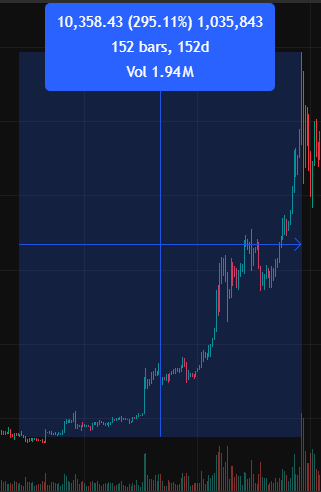
The last comparable event came in 2019, when a record-long U.S. shutdown ended after 35 days. Shortly afterward, Bitcoin began a sustained recovery, climbing from roughly $3,500 in late January 2019 to over $13,000 by mid-year. While correlation doesn’t imply causation, renewed fiscal clarity and market confidence often coincide with higher risk-appetite, the environment where crypto tends to thrive.
3. Pending ETF Approvals: Keep an Eye on XRP
Finally, the next big trigger could come from the regulatory side. Several new spot crypto ETF applications are nearing decision windows, with assets like XRP and Solana drawing heavy attention. The success of Bitcoin and Ethereum ETFs has already shown how much institutional demand can reshape liquidity and credibility in the space.
In particular, XRP could be one of the biggest winners. According to recent on-chain data, whales have accumulated more than $560 million worth of XRP in the past few weeks, a sign of growing confidence ahead of potential ETF approval. Broader adoption through regulated investment vehicles could finally unlock fresh capital inflows for alternative crypto assets beyond Bitcoin and Ethereum.
Bottom Line
Nothing is set in stone in crypto. But when liquidity, regulatory progress, and accumulation all start pointing in the same direction? That's when things get very interesting.
We're heading into the final stretch of 2025 with more aligned positive factors than we've seen in months. So, for anyone involved in crypto, whether you're trading daily or holding, now's the time to stay plugged in.

Το 2025 ήταν ένα καθοριστικό έτος για την τεχνητή νοημοσύνη. Το GPT-5 του OpenAI και ο Claude Sonnet 4.5 του Anthropic ανέβασε τον πήχη για άλλη μια φορά, καθεμία στοχεύοντας στο να συνδυάσει ισχυρότερη συλλογιστική, μεγαλύτερη μνήμη και περισσότερη αυτονομία σε ένα απρόσκοπτο σύστημα. Και οι δύο είναι κατασκευασμένες για να χειρίζονται εργασίες κωδικοποίησης, έρευνας, γραφής και επιχειρηματικής κλίμακας, ωστόσο οι φιλοσοφίες σχεδιασμού τους διαφέρουν απότομα.
Αυτή η ανάλυση διερευνά πώς οι δύο συνδυάζονται μεταξύ της απόδοσης, της συλλογιστικής, της κωδικοποίησης, των μαθηματικών, της αποτελεσματικότητας και του κόστους, βοηθώντας τους χρήστες και τις ομάδες να αποφασίσουν πού πραγματικά λάμπει κάθε μοντέλο.
Μια γρήγορη επισκόπηση
Το Claude Sonnet 4.5 βασίζεται στην εκλεπτυσμένη οικογένεια Claude του Anthropic. Επεκτείνει τη μνήμη σε συνεδρίες, χειρίζεται περιβάλλοντα εκατομμυρίων διακριτικών μέσω του Amazon Bedrock και του Vertex AI και διαθέτει έξυπνη διαχείριση περιβάλλοντος που αποτρέπει ξαφνικές περικοπές. Μπορεί να τρέξει αυτόνομα για 30 ώρες σε εκτεταμένες εργασίες, καθιστώντας το ιδανικό για συνεχείς ροές εργασίας.
Εν τω μεταξύ, το GPT-5 είναι ο κορυφαίος διάδοχος του OpenAI στο GPT-4, συντονισμένο για πρακτικό συλλογισμό, όπου το μοντέλο σχεδιάζει, εκτελεί και συντονίζει εργαλεία από μόνο του. Το προσαρμοστικό σύστημα συλλογιστικής του επιλέγει δυναμικά μεταξύ ρηχών ή βαθιών διαδρομών «σκέψης», επιτρέποντας στους χρήστες να εξισορροπήσουν ταχύτητα, κόστος και βάθος ανά εργασία. Το GPT-5 προσφέρει επίσης εξειδικευμένες παραλλαγές (Mini, Nano) για ελαφρύτερο φόρτο εργασίας.
Συστάσεις και Ανάλυση
Και τα δύο μοντέλα υπερβαίνουν κατά πολύ τα αντίστοιχα του 2024, αλλά διαφέρουν ως προς τον τρόπο που αιτιολογούν.
Η λειτουργία βαθιάς συλλογιστικής του GPT-5 ενισχύει σημαντικά την απόδοση σε λογικές, επιστημονικές και χωρικές εργασίες πολλαπλών βημάτων. Μπορεί να σπάσει τα προβλήματα σε αλυσίδες, να δοκιμάσει υπουποθέσεις και να αυτοδιορθώσει κατά τη διάρκεια της διαδικασίας. Ωστόσο, η απενεργοποίηση αυτής της λειτουργίας μειώνει απότομα την ακρίβεια, μπορεί να είναι λαμπρή όταν «σκέφτεσαι βαθιά», αλλά πιο μεταβλητή όταν όχι.
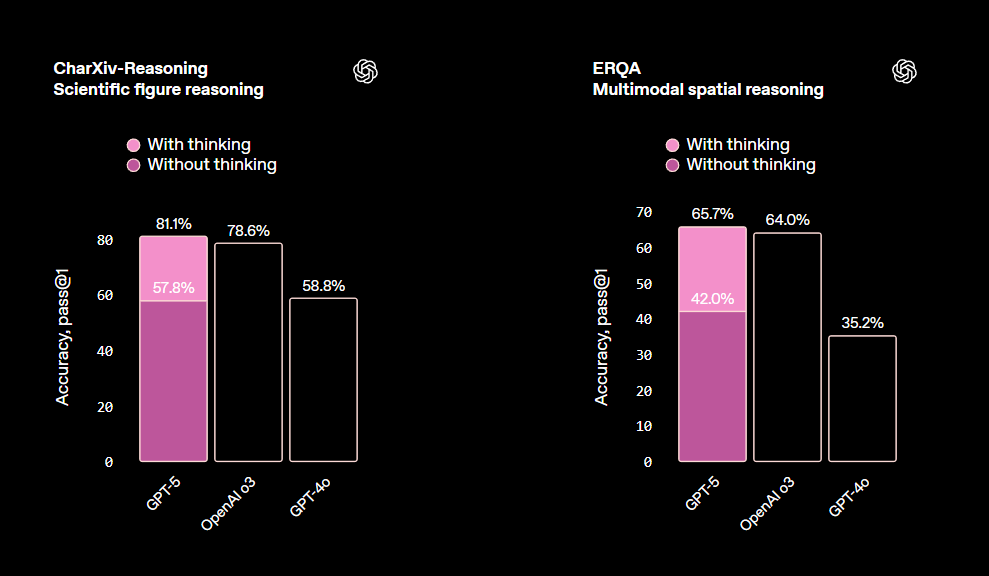
Το Claude Sonnet 4.5, αντίθετα, παραμένει σταθερό ακόμη και χωρίς πρόσθετη διαμόρφωση. Είναι ιδιαίτερα ισχυρό στην οικονομική, πολιτική και επιχειρηματική λογική, όπου η δομή και η συνοχή έχουν μεγαλύτερη σημασία από τα δημιουργικά άλματα. Για επιχειρηματικές ερωτήσεις και απαντήσεις ή υποστήριξη αποφάσεων, αυτή η προβλεψιμότητα είναι πολύτιμη.

Αν θέλετε μια τεχνητή νοημοσύνη που αιτιολογεί σταθερά, ο Claude αναλαμβάνει το προβάδισμα. Εάν χρειάζεστε διερευνητική λογική (δηλαδή δοκιμή σύνθετων υποθέσεων ή σύνθεση μεταξύ τομέων) η βαθύτερη διαδρομή του GPT-5 είναι απαράμιλλη.
Μαθηματικά και δομημένη επίλυση προβλημάτων
Όπως φαίνεται στα σημεία αναφοράς που παρέχονται από το Anthropic, το Claude Sonnet 4.5 συνεχίζει τη σειρά συνέπειάς του. Είτε υπολογίζει απευθείας είτε χρησιμοποιεί εργαλεία Python, επιτυγχάνει κορυφαία μαθηματική ακρίβεια. Αυτό σημαίνει ότι χειρίζεται δομημένη λογική ακόμη και σε περιορισμένα περιβάλλοντα.
Το GPT-5 φτάνει επίσης σχεδόν τέλεια ακρίβεια, αλλά μόνο όταν η χρήση εργαλείου και το βάθος συλλογισμού είναι ενεργές. Απενεργοποιήστε τα και τα αποτελέσματα μειώνονται αισθητά. Βασίζεται σε μεγάλο βαθμό στον αγωγό συλλογισμού του για να παραμείνει αιχμηρό.
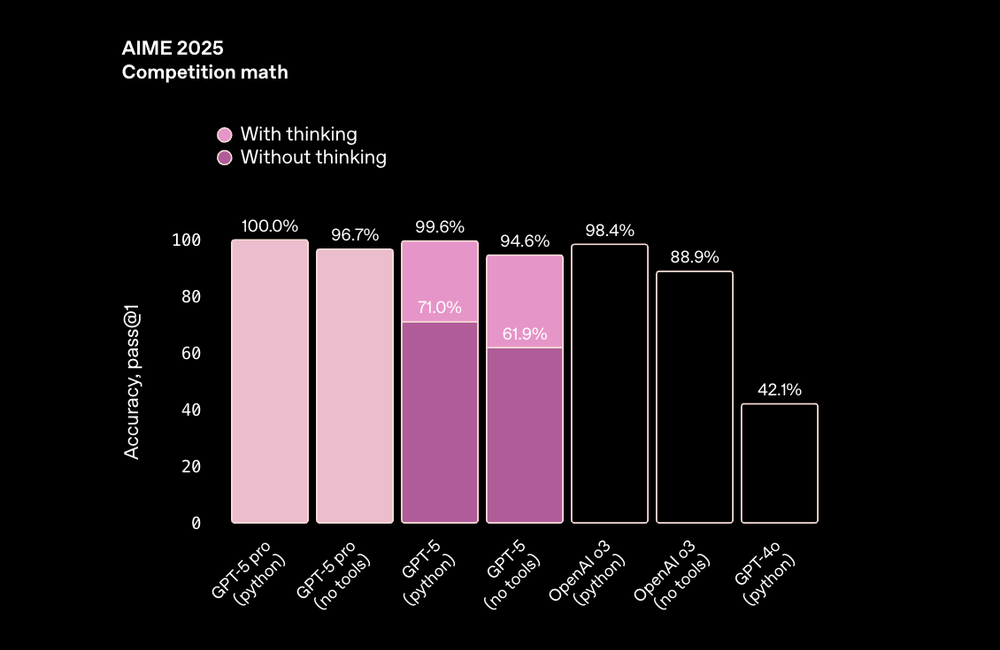
Ετυμηγορία:
- Claude Sonnet 4.5: αξιόπιστος λύτης μαθηματικών εκτός κουτιού.
- GPT-5: ευέλικτο αλλά χρειάζεται συντονισμό για να αποδώσει στα καλύτερά του.
Κωδικοποίηση και Μηχανική Λογισμικού
Όσον αφορά την κωδικοποίηση, τα δύο μοντέλα αποκλίνουν σε στυλ.
Το Claude Sonnet 4.5 προσφέρει σταθερή απόδοση χωρίς ειδικό συντονισμό. Σε δοκιμές που μοιάζουν με HumaneVal+ και MBPP+, διατηρεί υψηλή ακρίβεια σε όλες τις συνθήκες, καθιστώντας το αξιόπιστο για αγωγούς παραγωγής. Η δύναμή του έγκειται στη συνέπεια, τα αποτελέσματα σπάνια κυμαίνονται, κάτι που είναι ζωτικής σημασίας για την επιχειρηματική χρήση.

Αντίθετα, το GPT-5 επιτυγχάνει υψηλότερες κορυφαίες βαθμολογίες όταν ενεργοποιείται η προηγμένη συλλογιστική του, ειδικά σε περιβάλλοντα πολλαπλών γλωσσών ή μεγάλων έργων. Στις εργασίες αναδιαμόρφωσης JavaScript και Python, για παράδειγμα, ξεπέρασε το Sonnet όταν ήταν ενεργή η λειτουργία «υψηλού συλλογισμού» - αν και οι βασικές εκτελέσεις χωρίς αυτήν τη λειτουργία διέφεραν περισσότερο.
Για την κωδικοποίηση πράκτορας, όπου η τεχνητή νοημοσύνη καλεί εξωτερικά εργαλεία ή τερματικά, το Sonnet 4.5 εκτελείται συχνά με λιγότερες εντολές που έχουν διακοπεί. Το GPT-5, από την άλλη πλευρά, μπορεί να αλυσοθετήσει περισσότερες κλήσεις εργαλείων ταυτόχρονα, καθιστώντας το καλύτερο για πολύπλοκη ενορχήστρωση, υπό την προϋπόθεση ότι το διαμορφώνετε προσεκτικά.
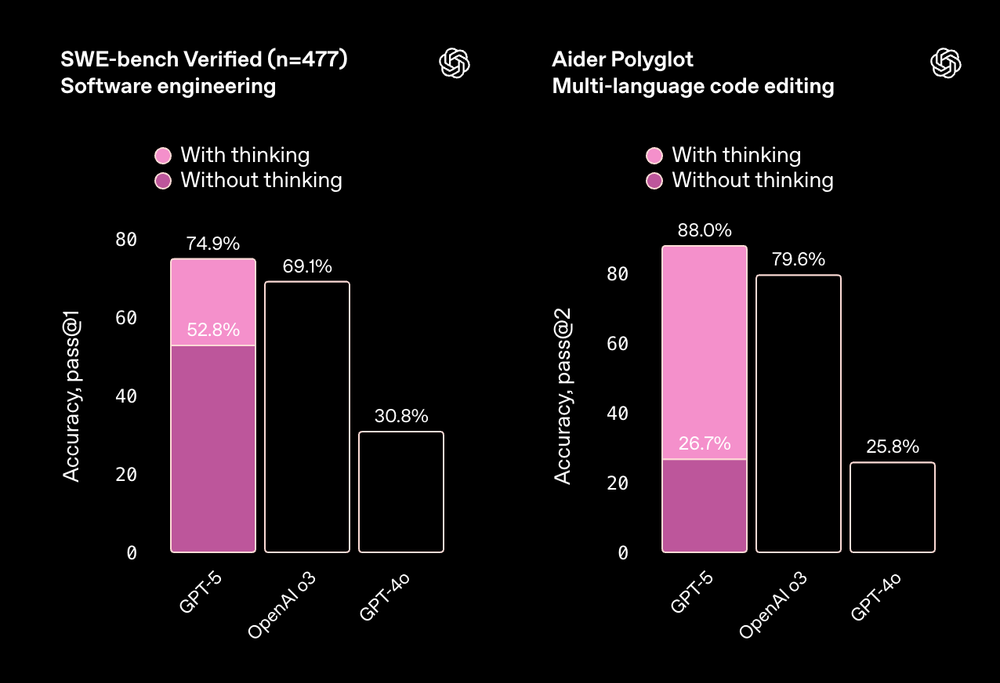
Ετυμηγορία:
- Claude Sonnet 4.5: προβλέψιμος, σταθερός συνεργάτης μηχανικής.
- GPT-5: ευέλικτο εργοστάσιο παραγωγής ενέργειας, αλλά η απόδοση εξαρτάται από τη ρύθμιση.
Κόστος και αποδοτικότητα
GPT-5 είναι σαφώς φθηνότερο ανά διακριτικό, ειδικά για μεγάλες εισόδους. Ο προσαρμοστικός δρομολογητής του εξοικονομεί επίσης υπολογιστές εκτελώντας απλές προτροπές σε ελαφρύτερες διαδρομές.
Κλοντ Σονέ 4.5 χρεώνει περισσότερο αλλά διατηρεί προβλέψιμη καθυστέρηση, ένας βασικός παράγοντας για περιβάλλοντα παραγωγής που εκτιμούν την αξιοπιστία έναντι της οριακής εξοικονόμησης. Για πολύ μεγάλες προτροπές, το κόστος του αυξάνεται γρηγορότερα από το GPT-5, ωστόσο εκπτώσεις παρτίδας περιορίστε το κενό.
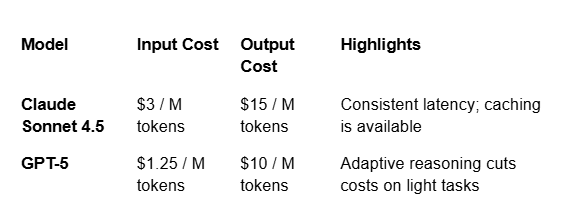
ΤΛ; ΔΡ: Το GPT-5 κερδίζει στην τιμή και την επεκτασιμότητα, ενώ ο Claude κερδίζει στη συνέπεια και τη σταθερότητα του χρονισμού.
Τιμολόγηση για Πακέτα Premium
Πέρα από την πρόσβαση API, τόσο το OpenAI όσο και το Anthropic προσφέρουν premium συνδρομές για μεμονωμένους χρήστες, οι οποίες διαφέρουν ως προς τις δυνατότητες και τις τιμές.
Το ChatGPT Plus, που υποστηρίζεται από το GPT-5, διατίθεται σε 20$ ανά μήνα, δίνοντας στους χρήστες προτεραιότητα πρόσβαση στο GPT-5, γρηγορότερους χρόνους απόκρισης και έγκαιρη πρόσβαση σε νέες δυνατότητες και μνήμη. Η ενοποιημένη εμπειρία ChatGPT του OpenAI περιλαμβάνει επίσης μεταφορτώσεις αρχείων, δημιουργία εικόνων και προσαρμοσμένα GPT.
Το Claude Pro, εν τω μεταξύ, κοστίζει επίσης 20$ το μήνα και παρέχει πρόσβαση στο Claude Sonnet 4.5, προσφέροντας ταχύτερες απαντήσεις, υψηλότερα όρια τιμών και μεγαλύτερα παράθυρα περιβάλλοντος. Ενώ δεν διαθέτει ενσωματωμένα πολυτροπικά εργαλεία, ο Claude επικεντρώνεται στη σαφήνεια κειμένου και στη δομημένη συλλογιστική, προσελκύοντας ερευνητές, αναλυτές και συγγραφείς που αναζητούν αξιοπιστία έναντι της ευελιξίας.
ΤΛ; ΔΡ: και τα δύο πακέτα Plus είναι συνδεδεμένα στην τιμή. Αυτό που τα ξεχωρίζει, ωστόσο, είναι η προσφορά τους.
Διαφορετικές δυνάμεις για διαφορετικές ανάγκες
Είναι δελεαστικό να στεφθεί ένα «καλύτερο», αλλά το GPT-5 και το Claude Sonnet 4.5 εξυπηρετούν διαφορετικές προτεραιότητες για διαφορετικούς χρήστες και ομάδες.
- Claude Sonnet 4.5: καλύτερο για αξιοπιστία και συνεχή απόδοση. Εάν θέλετε συνεπείς εξόδους και καθαρή συμπεριφορά μνήμης, ο Claude παραδίδει.
- GPT-5: καλύτερο για βάθος, ευελιξία και επεκτασιμότητα. Όταν διαμορφωθεί σωστά, ξεπερνά τους αντιπάλους στη δημιουργική συλλογιστική, την πολυτροπική ενσωμάτωση και την προσαρμοστική χρήση εργαλείων.
Οι περισσότερες ομάδες μπορεί να βρουν ότι η ισχυρότερη ρύθμιση είναι πολλαπλών μοντέλων, χρησιμοποιώντας το Claude όπου η συνέπεια έχει μεγαλύτερη σημασία και το GPT-5 για ροές εργασίας υψηλής έντασης δεδομένων.
Τελικά, αυτά δεν είναι πλέον μόνο chatbots, είναι πλήρεις ψηφιακοί συνεργάτες, ο καθένας με ξεχωριστές προσωπικότητες. Ο Claude Sonnet 4.5 είναι ο ήρεμος, μεθοδικός αναλυτής σας. Το GPT-5 είναι ο φιλόδοξος πολυμαθής σας. Ποιο θα επιλέξετε εξαρτάται λιγότερο από τα μεμονωμένα σημεία αναφοράς τους και περισσότερο από την αποστολή σας.

After a volatile October that saw one of the sharpest two-day liquidations of the year, the crypto market is trying to regain its footing, but conviction remains divided. Bitcoin has stabilized near key support levels, while altcoins fight against selling pressure. With macro, policy, and on-chain factors all in play, the debate between the bull and bear camps is as alive as ever. Let’s unpack the forces shaping both sides of the ledger.
The Bear Case
When Good News Don’t Move Prices
Despite encouraging ETF data and easing rate expectations, crypto failed to rally in late October, a classic warning sign of risk fatigue. According to Farside Investors, U.S. spot Bitcoin ETFs saw outflows of $470 million, $488 million, and $191 million between October 29 and 31, signaling that short-term traders were taking profits or stepping aside after “Uptober” fizzled out.
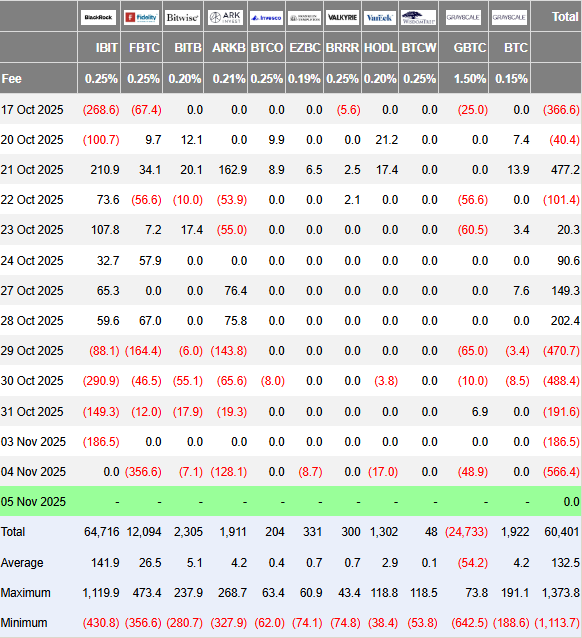
The AI Narrative
Macro sentiment still casts a long shadow. The tech-heavy equity rally, driven by AI infrastructure and chip stocks, has stirred debate about overvaluation. Nvidia’s brief breach of a $5 trillion valuation in late October triggered flashbacks of the dot-com era. If AI equities begin to deflate, crypto could feel the wealth effect unwind, as liquidity shifts from speculative assets to safer havens.
The 10/10 Crash Aftershock
The October 10 downturn marked one of the largest single-day liquidations in recent memory. Analysts note that this event left traders hunting for “dead entities” and potential hidden losses, injecting caution across the market. Even with recovery underway, scars from that drop remain fresh.
Post-Halving Cycle Timing
Bitcoin’s halving on April 20, 2024 (block 840,000) reset expectations, but it also reignited the age-old question: where are we in the cycle? Historically, the strongest rallies have occurred before or shortly after the halving, not a full year later. Some analysts now argue that the current consolidation could represent a late-cycle phase rather than the start of a new one.
Dormant Wallets Awakening
On-chain data from CryptoQuant shows that long-term holders have increased net distribution since mid-October, with tens of thousands of BTC re-entering circulation. Several Satoshi-era wallets have also moved funds, not necessarily bearish in isolation, but enough to add pressure and short-term supply.
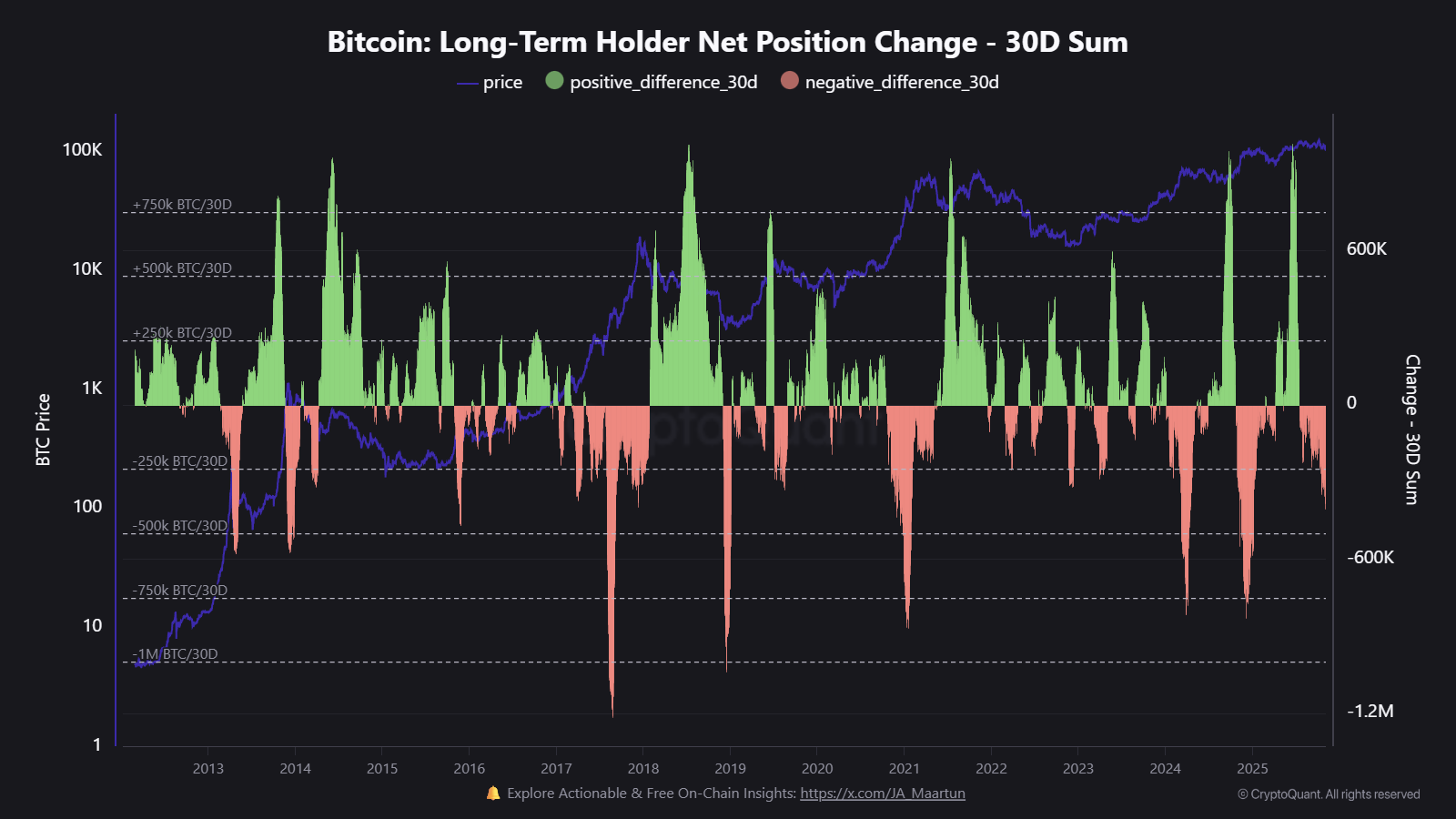
The Bull Case
No Signs of Euphoria
Market positioning remains far from overheated. The Crypto Fear & Greed Index currently sits in the 20s, and has been recently hovering between “Fear” and “Neutral.” That’s a far cry from the exuberant 80s to 90s readings that often precede blow-off tops. In practical terms, this suggests there’s still room for sentiment to improve before the market becomes dangerously crowded.
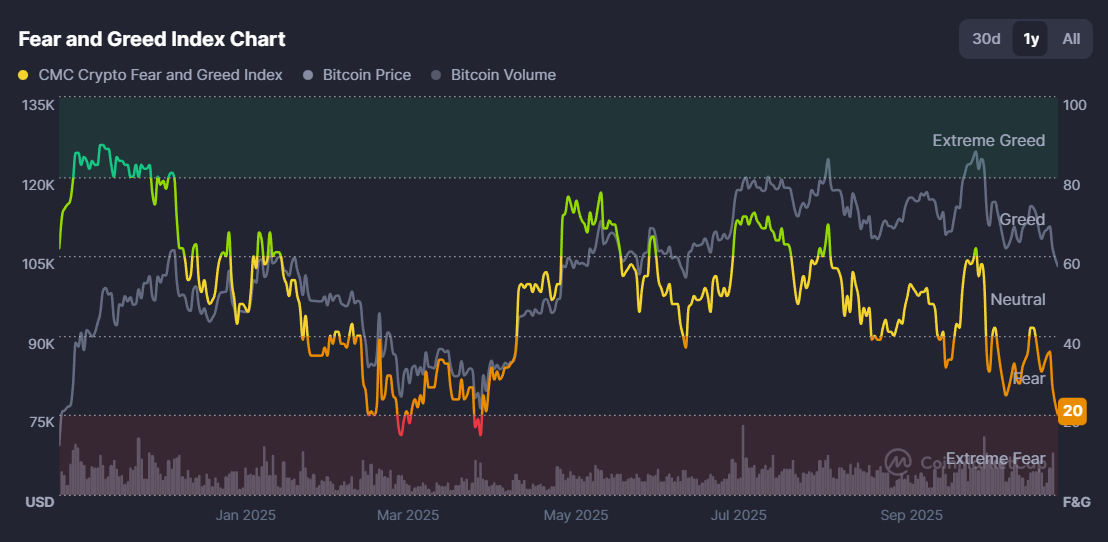
Liquidity Is Turning
Central banks are easing. The European Central Bank has already paused, the Bank of England has begun cutting, and the U.S. Federal Reserve is expected to follow suit with at least one more rate cut by year-end. According to the CME FedWatch Tool, the odds of a 0.25% cut currently stand above 70%. Historically, easing cycles have correlated strongly with renewed crypto uptrends, as lower yields push investors back into risk assets.
Institutional Adoption Keeps Compounding
Spot ETFs remain the biggest driver of credibility and inflows this year. Despite short-term outflows, global crypto investment products reached $921 million as recently as last week. That steady institutional presence gives crypto markets deeper liquidity and a stronger foundation than in previous cycles, where retail speculation dominated.
The Seasonal Edge
Seasonality adds another bullish data point. Since 2013, Q4 has consistently been Bitcoin’s strongest quarter on average. With November historically delivering above-average performance, many traders see the current consolidation not as a ceiling, but as a potential setup, particularly if macro data softens and ETF inflows resume.
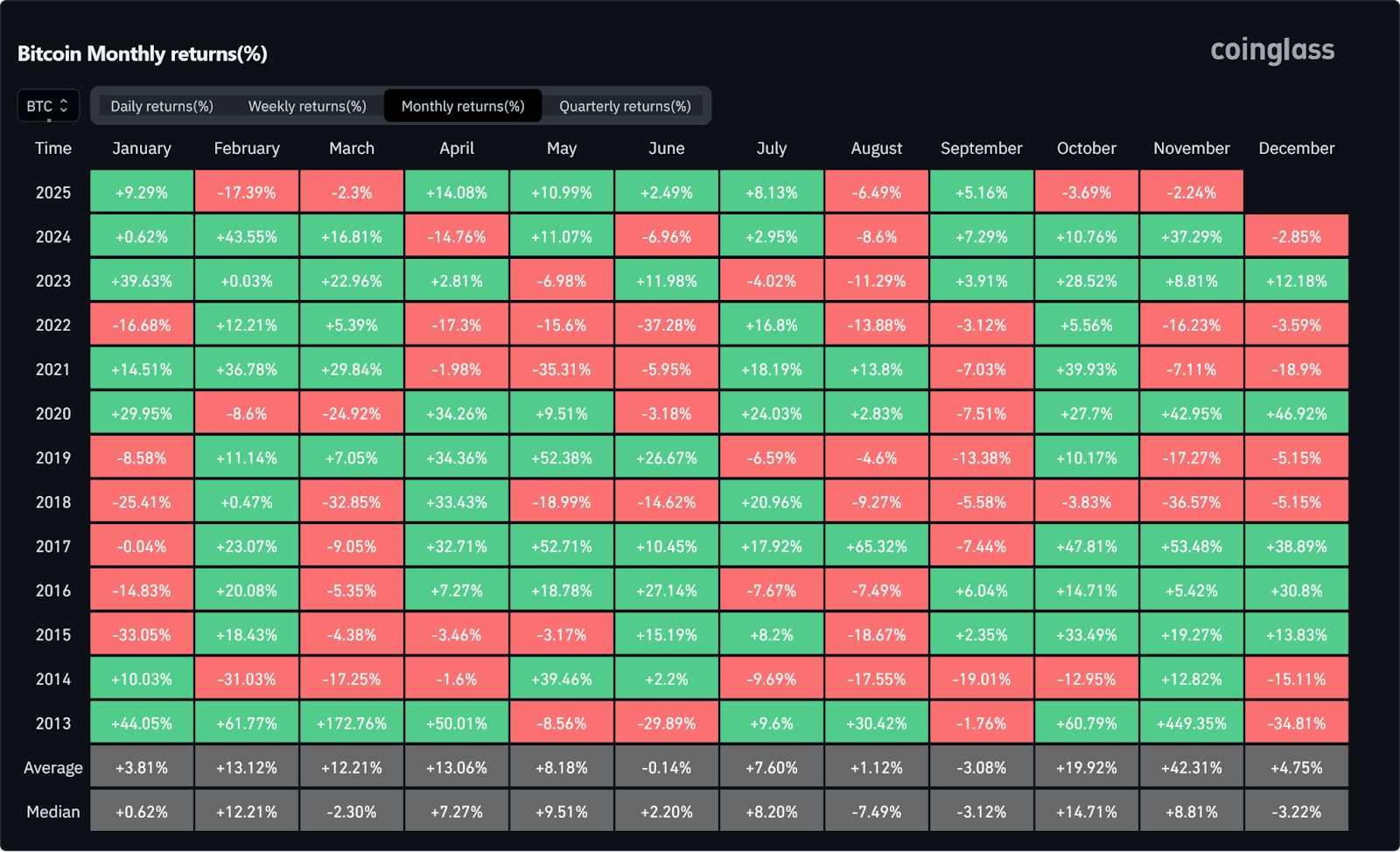
Improving Global Sentiment
Finally, the U.S.–China trade thaw is a quiet but important catalyst. China has agreed to pause 24% tariffs on U.S. goods, marking the most significant de-escalation yet. For global risk assets, that’s a relief valve, potentially restoring confidence in emerging markets and crypto alike.
Final Verdict
Crypto’s tug-of-war between optimism and caution is far from over. The bull camp points to liquidity, policy progress, and institutional growth as evidence of a maturing ecosystem. The bears, on the other hand, warn that cycle timing, macro fragility, and old-wallet selling could cap any short-term rally.
Currently, the most realistic view lies somewhere in between these two extremes. After October's flash crash sent shockwaves through the market, a period of recalibration has taken hold. Whenever the next significant high arrives, the current environment may be best described not as peak fear or euphoria, but as consolidation.

Όταν ο Satoshi Nakamoto δημιούργησε το Bitcoin, το σχεδίασε με τέτοιο τρόποώστε, αν η αξία του αυξηθεί δραματικά, να υπάρχει ακόμα μία συμπεριληπτικήδεκαδική μονάδα για τον λαό. Οι Satoshis ενδέχεται μια μέρα να είναι ο τρόποςμε τον οποίο θα αγοράζουμε έναν καφέ οπουδήποτε στον κόσμο, χρησιμοποιώντας τοίδιο νόμισμα από τη Βρετανία μέχρι την Ιαπωνία.
Πόσοι Satoshis υπάρχουν σε ένα Bitcoin;
Όπως και τα παραδοσιακά νομίσματα, τα κρυπτονομίσματα μπορούν να χωριστούν σεμικρότερες μονάδες. Ενώ το δολάριο και το ευρώ έχουν τα λεπτά ως τη μικρότερημονάδα, το Bitcoin έχει τους Satoshis (ή SATs). Αλλά σε αντίθεση με τα λεπτά,οι Satoshis είναι το 100 εκατομμυριοστό του Bitcoin, πράγμα που σημαίνει ότι τοBitcoin μπορεί να χωριστεί σε 100 εκατομμύρια μονάδες, δηλαδή 18 δεκαδικέςθέσεις.
Δείτε τον παρακάτω πίνακα που δείχνει τις διάφορες αξίες του Bitcoin σεσχέση με τους Satoshis.
Πόσοι Satoshis υπάρχουν σε ένα Bitcoin, ακριβώς;
1 Satoshi = 0.00000001 Bitcoin
10 Satoshis = 0.00000010 Bitcoin
100 Satoshis = 0.00000100 Bitcoin
1.000 Satoshis = 0.00001000 Bitcoin
10.000 Satoshis = 0.00010000 Bitcoin
100.000 Satoshis = 0.00100000 Bitcoin
1.000.000 Satoshis = 0.01000000 Bitcoin
10.000.000 Satoshis = 0.10000000 Bitcoin
100.000.000 Satoshis = 1.00000000 Bitcoin
Όπως ορίζεται από την τεχνολογία, θα υπάρχουν μόνο 21 εκατομμύρια Bitcoin,πράγμα που σημαίνει ότι θα υπάρξουν συνολικά 210.000.000.000.000 Satoshis.Είναι ένας δύσκολος αριθμός να κατανοήσεις. Όπως αναφέρθηκε παραπάνω, η σύνδεσημεταξύ Satoshis και Bitcoin εκτείνεται σε αρκετές δεκαδικές θέσεις, κάτι πουσίγουρα δεν μας το δίδαξαν στο σχολείο. Ένα λιγότερο περίπλοκο σημείο για να τοαφομοιώσουμε είναι ότι οι Satoshis ονομάστηκαν έτσι από τον δημιουργό τουBitcoin, τον Satoshi Nakamoto.
Μονάδες μέτρησης του Bitcoin
Ο δημιουργός του peer-to-peer ψηφιακού νομίσματος είχε αναφέρει στις αρχικέςαναλύσεις του whitepaper του Bitcoin τις δεκαδικές μονάδες στις οποίες μπορείνα διαιρεθεί το Bitcoin. Στο whitepaper αναφέρονταν μόνο δύο μονάδες μέτρησης:το ίδιο το Bitcoin και οι Satoshis. Μερικά χρόνια αργότερα, καθώς η τιμή τουBTC συνέχισε να αυξάνεται, οι έρευνες και οι συζητήσεις στην αγορά οδήγησανστην απόφαση να προστεθούν περισσότερες μονάδες μέτρησης.
Πέντε χρόνια μετά την εξαφάνιση του Satoshi Nakamoto από τα διαδικτυακάφόρουμ, κυκλοφόρησε μια παγκόσμια ενημέρωση ISO που αναγνώρισε δύο νέες μονάδεςμέτρησης του Bitcoin.
• MicroBitcoin (μBTC)
1 BTC = 1.000.000 MicroBitcoins (μBTC) = 100 SATs
• MilliBitcoin (mBTC)
1 BTC = 1.000 MilliBitcoins (mBTC) = 100.000 SATs
Όταν ρίχνετε μια ματιά στο πορτοφόλι σας για Bitcoin, μπορείτε να επιλέξετενα δείτε τους Satoshis, MicroBitcoins ή MilliBitcoins. Όμως, πιθανότατα θαχρειαστούν αρκετά χρόνια μέχρι να αναφερόμαστε σε αγορές αγαθών με SATs.
Πώς να υπολογίσετε τα SATs
Όπως έχουμε ήδη αναφέρει παραπάνω, 1 BTC ισοδυναμεί με 100.000.000 SATs. Ενώκάποιος μπορεί να κάνει τον υπολογισμό μόνος του, υπάρχουν πολλά εργαλείαδιαθέσιμα στο διαδίκτυο που μπορούν να κάνουν τους υπολογισμούς για εσάς.Επιπλέον, καθώς οι Satoshis αναγνωρίζονται ως παγκόσμιες μονάδες αξίας,μπορείτε να αλλάξετε τη ρύθμιση νομίσματος σε διάφορους ιστότοπους.
Για παράδειγμα, στο Coin Market Cap μπορείτε να αλλάξετε το προεπιλεγμένονόμισμα σε SATs επιλέγοντας την επιλογή "Currency" στην πάνω δεξιάγωνία και επιλέγοντας την επιλογή "Satoshi" στις μονάδες του Bitcoin.
Αυτό θα εμφανίσει όλες τις αξίες ως Satoshis.
Εναλλακτικά, μπορείτε να χρησιμοποιήσετε έναν από τους πολλούς υπολογιστέςSatoshi που είναι διαθέσιμοι online, οι οποίοι θα μετατρέψουν την αξία τουνομίσματός σας σε SATs αμέσως. Στο μέλλον, όταν χρησιμοποιούμε τα SATs ως μέσοπληρωμής, η οφειλόμενη αξία πιθανότατα θα σας παρουσιαστεί με την ίδια μορφή,προσφέροντας μια πολύ πιο εύκολη εμπειρία για τον καταναλωτή.
Συμπεράσματα
Οι SATs χρησιμοποιούνται από το δίκτυο Bitcoin και τις κρυπτονομισματικέςανταλλαγές. Οι miners στο blockchain του Bitcoin χρησιμοποιούν τους SATs για νακαθορίσουν την αμοιβή τους για τις επικυρωμένες συναλλαγές, ενώ μερικέςανταλλαγές χρησιμοποιούν SATs για να μετρήσουν την αξία και την απόδοση τωνaltcoins σε σχέση με το Bitcoin.
Είναι πιθανό ότι στο μέλλον, όταν το Bitcoin ενσωματωθεί πλήρως σταχρηματοοικονομικά συστήματά μας, οι τιμές στα καταστήματα και τα σούπερ μάρκετθα αποδίδονται σε SATs αντί για BTC.
Αποποίηση Ευθύνης
Αυτό το άρθρο παρέχεται μόνο για γενικές πληροφορίες και δεν έχει σκοπό νααποτελεί νομική, οικονομική ή άλλη επαγγελματική συμβουλή ή σύσταση. Δεν πρέπεινα βασίζεστε σε αυτό ή να το θεωρείτε υποκατάστατο συγκεκριμένων συμβουλών πουσχετίζονται με τις προσωπικές σας περιστάσεις. Δεν παρέχουμε καμία εγγύηση γιατην ποιότητα, την ακρίβεια ή την πληρότητα του περιεχομένου αυτού ήοποιουδήποτε άλλου υλικού που αναφέρεται ή αποκτάται μέσω υπερσυνδέσμων σε αυτότο άρθρο.

You’ve probably heard whispers about the "whales" swimming in the crypto seas. But these aren’t your typical marine mammals. They’re the ultra-wealthy folks and organizations holding massive amounts of digital currency.
What Exactly is a Crypto Whale?
So, what makes someone a crypto whale? There’s no hard-and-fast rule, but it generally comes down to owning a huge chunk of a coin’s total supply. If we’re talking over 10% of the available coins for a particular cryptocurrency, then that’s an ocean-sized wallet!
Take Bitcoin, for example. In October 2025, the wealthiest addresses controlled over 14% of all Bitcoin in existence. From Satoshi Nakamoto himself to MicroStrategy. Now that’s some serious whale power!
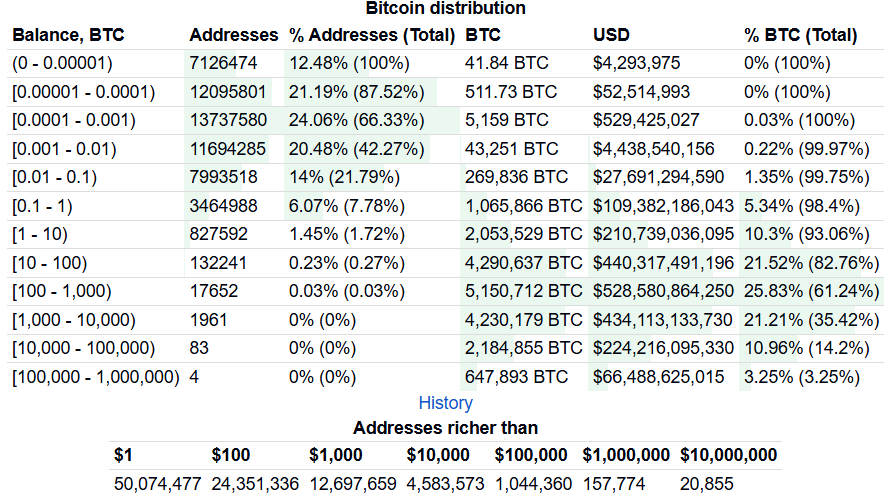
Bitcoin isn’t the only one with its share of whales. Dogecoin, the beloved meme coin, had a pretty wild concentration too. In 2025, just 3 addresses held over 32% of its total supply. Even Vitalik Buterin, the mastermind behind Ethereum, is considered an Ether whale thanks to his massive stake in the coin he created.
How Much Money Makes You a Crypto Whale?
The exact percentage threshold varies by cryptocurrency, but Bitcoin probably offers the clearest benchmark. Analysts typically define a Bitcoin whale as anyone holding over 1,000 BTC, worth around $100 million USD at recent 2025 market prices.
What About Other Assets?
- Whales usually hold 10,000 ETH or more.
- Generally, 500,000 SOL or more.
These thresholds aren’t clear-cut, and they shift as market value, liquidity, and overall supply and demand evolve. In simple terms, whales are the elite of the cryptocurrency market, capable of moving markets with a single transaction.
How Whales Make Waves
With that kind of buying power, whales can really make waves in the crypto marketplace. If a whale decides to sell off a giant chunk of their holdings, it creates a tidal wave of downward pressure on prices due to the sheer volume and lack of liquidity. Other crypto enthusiasts are always on the lookout for signs of an impending "whale dump," closely monitoring exchange inflows to spot potential dangers.
Here’s the twist, though – whales keeping their coins locked away actually reduces trading liquidity in the market since there are fewer coins actively circulating. Their massive idle fortunes are like icebergs weighing down the crypto ocean.
Tracking Whale Movements
Not every whale transaction is a sell-off. These giants could simply be migrating to new wallets, switching exchanges, or making monster-sized purchases. But you can bet experienced crypto folks keep a keen eye on those huge whale wallets, carefully tracking any ripples they make to navigate the ever-shifting tides of the market.
Whale Alert is a popular service that tracks these large transactions and reports them, often on Twitter. Whenever a whale makes a big move, it’s usually publicized quickly, giving everyone a heads-up on potential market changes.
Below is an example from Twitter from Whale Alert:

The Human Side of Whales
Behind these massive holdings are real people and organizations. Some whales are early adopters who bought into Bitcoin or other cryptocurrencies when they were cheap. Others are companies that have invested heavily in the belief that cryptocurrencies will continue to grow in value. For instance, Ethereum’s founder, Vitalik Buterin, is the biggest Ethereum whale because he holds a significant amount of the cryptocurrency he created.
How Whales Affect Crypto's Price
Price volatility can be increased by whales, particularly when they move a significant amount of one cryptocurrency in one go. For example, when an owner tries to sell their BTC for fiat currency, the lack of liquidity and enormous transaction size create downward pressure on Bitcoin's price. When whales sell, other investors become extremely vigilant, looking for hints of whether the whale is "dumping" their crypto (and whether they should do the same).
The exchange inflow mean, also known as the average amount of a certain cryptocurrency deposited into exchanges, is one of the most common indicators crypto investors look for. If the mean transaction volume rises above 2.0, it implies that whales are likely to start dumping if there are a large number of them using the exchange. This can be viewed by regular crypto traders as a time to act before losing any potential profit.
How Whales Affect Liquidity
When it comes to learning about whales and liquidity, one must remember that while whales are generally considered neutral elements in the industry, when a large number of whales hold a particular cryptocurrency, instead of using it, this reduces the liquidity in the market due to there being fewer coins available.
What Crypto Whales Mean to Investors
In terms of the relationship between whales and investors, one must remember that there are various situations in which a person may transfer their cryptocurrency holdings. It's worth mentioning that moving one's assets doesn't always indicate that you're selling them; they might be switching wallets or exchanges, or making a major purchase.
Occasionally, whales may sell portions of their holdings in discrete transactions over a longer period to avoid drawing attention to themselves or generating market anomalies that send the price up or down unpredictably. This is why investors keep an eye on known whale addresses to check for the number of transactions and value. This is not necessarily a task that newbie investors need to actively be involved with, however, understanding the terms and how whale accounts can affect the market is recommended.
Why Whales Matter
Whether you love them or hate them, whales are a formidable force in the crypto world, shaping its dynamics in profound ways. These giants, whether they’re creators, collectors, or traders, have a tremendous impact across the digital waters. When they make a move, it can trigger monumental swells that ripple through the entire market.
By understanding whale activity, anyone involved in cryptocurrency can better navigate these choppy waters. Staying informed about whale movements helps both newbies and seasoned traders make smarter decisions and stay afloat in this ever-changing space. Keep an eye on these behemoths; their actions can significantly influence your crypto journey.
While tracking whale activity can offer valuable insights into the cryptocurrency market, it's important to complement this knowledge with expert advice. Consulting with a financial advisor can help you navigate the complexities of investing and ensure your strategies align with your personal financial goals and risk tolerance.
TAP'S NEWS AND UPDATES
What’s a Rich Text element?
What’s a Rich Text element?The rich text element allows you to create and format headings, paragraphs, blockquotes, images, and video all in one place instead of having to add and format them individually. Just double-click and easily create content.
The rich text element allows you to create and format headings, paragraphs, blockquotes, images, and video all in one place instead of having to add and format them individually. Just double-click and easily create content.Static and dynamic content editing
Static and dynamic content editingA rich text element can be used with static or dynamic content. For static content, just drop it into any page and begin editing. For dynamic content, add a rich text field to any collection and then connect a rich text element to that field in the settings panel. Voila!
A rich text element can be used with static or dynamic content. For static content, just drop it into any page and begin editing. For dynamic content, add a rich text field to any collection and then connect a rich text element to that field in the settings panel. Voila!How to customize formatting for each rich text
How to customize formatting for each rich textHeadings, paragraphs, blockquotes, figures, images, and figure captions can all be styled after a class is added to the rich text element using the "When inside of" nested selector system.
Headings, paragraphs, blockquotes, figures, images, and figure captions can all be styled after a class is added to the rich text element using the "When inside of" nested selector system.What’s a Rich Text element?
What’s a Rich Text element?The rich text element allows you to create and format headings, paragraphs, blockquotes, images, and video all in one place instead of having to add and format them individually. Just double-click and easily create content.
The rich text element allows you to create and format headings, paragraphs, blockquotes, images, and video all in one place instead of having to add and format them individually. Just double-click and easily create content.Static and dynamic content editing
Static and dynamic content editingA rich text element can be used with static or dynamic content. For static content, just drop it into any page and begin editing. For dynamic content, add a rich text field to any collection and then connect a rich text element to that field in the settings panel. Voila!
A rich text element can be used with static or dynamic content. For static content, just drop it into any page and begin editing. For dynamic content, add a rich text field to any collection and then connect a rich text element to that field in the settings panel. Voila!How to customize formatting for each rich text
How to customize formatting for each rich textHeadings, paragraphs, blockquotes, figures, images, and figure captions can all be styled after a class is added to the rich text element using the "When inside of" nested selector system.
Headings, paragraphs, blockquotes, figures, images, and figure captions can all be styled after a class is added to the rich text element using the "When inside of" nested selector system.What’s a Rich Text element?
What’s a Rich Text element?The rich text element allows you to create and format headings, paragraphs, blockquotes, images, and video all in one place instead of having to add and format them individually. Just double-click and easily create content.
The rich text element allows you to create and format headings, paragraphs, blockquotes, images, and video all in one place instead of having to add and format them individually. Just double-click and easily create content.Static and dynamic content editing
Static and dynamic content editingA rich text element can be used with static or dynamic content. For static content, just drop it into any page and begin editing. For dynamic content, add a rich text field to any collection and then connect a rich text element to that field in the settings panel. Voila!
A rich text element can be used with static or dynamic content. For static content, just drop it into any page and begin editing. For dynamic content, add a rich text field to any collection and then connect a rich text element to that field in the settings panel. Voila!How to customize formatting for each rich text
How to customize formatting for each rich textHeadings, paragraphs, blockquotes, figures, images, and figure captions can all be styled after a class is added to the rich text element using the "When inside of" nested selector system.
Headings, paragraphs, blockquotes, figures, images, and figure captions can all be styled after a class is added to the rich text element using the "When inside of" nested selector system.
Say goodbye to low-balance stress! Auto Top-Up keeps your Tap card always ready, automatically topping up with fiat or crypto. Set it once, and you're good to go!
Read moreWhat’s a Rich Text element?
What’s a Rich Text element?The rich text element allows you to create and format headings, paragraphs, blockquotes, images, and video all in one place instead of having to add and format them individually. Just double-click and easily create content.
The rich text element allows you to create and format headings, paragraphs, blockquotes, images, and video all in one place instead of having to add and format them individually. Just double-click and easily create content.Static and dynamic content editing
Static and dynamic content editingA rich text element can be used with static or dynamic content. For static content, just drop it into any page and begin editing. For dynamic content, add a rich text field to any collection and then connect a rich text element to that field in the settings panel. Voila!
A rich text element can be used with static or dynamic content. For static content, just drop it into any page and begin editing. For dynamic content, add a rich text field to any collection and then connect a rich text element to that field in the settings panel. Voila!How to customize formatting for each rich text
How to customize formatting for each rich textHeadings, paragraphs, blockquotes, figures, images, and figure captions can all be styled after a class is added to the rich text element using the "When inside of" nested selector system.
Headings, paragraphs, blockquotes, figures, images, and figure captions can all be styled after a class is added to the rich text element using the "When inside of" nested selector system.Έτοιμος για το πρώτο βήμα;
Γίνε μέρος της νέας γενιάς έξυπνων επενδυτών και όσων ξέρουν να διαχειρίζονται το χρήμα. Ξεκλείδωσε νέες δυνατότητες και ξεκίνα το δικό σου μονοπάτι προς την επιτυχία — σήμερα.
Ξεκίνα τώρα








